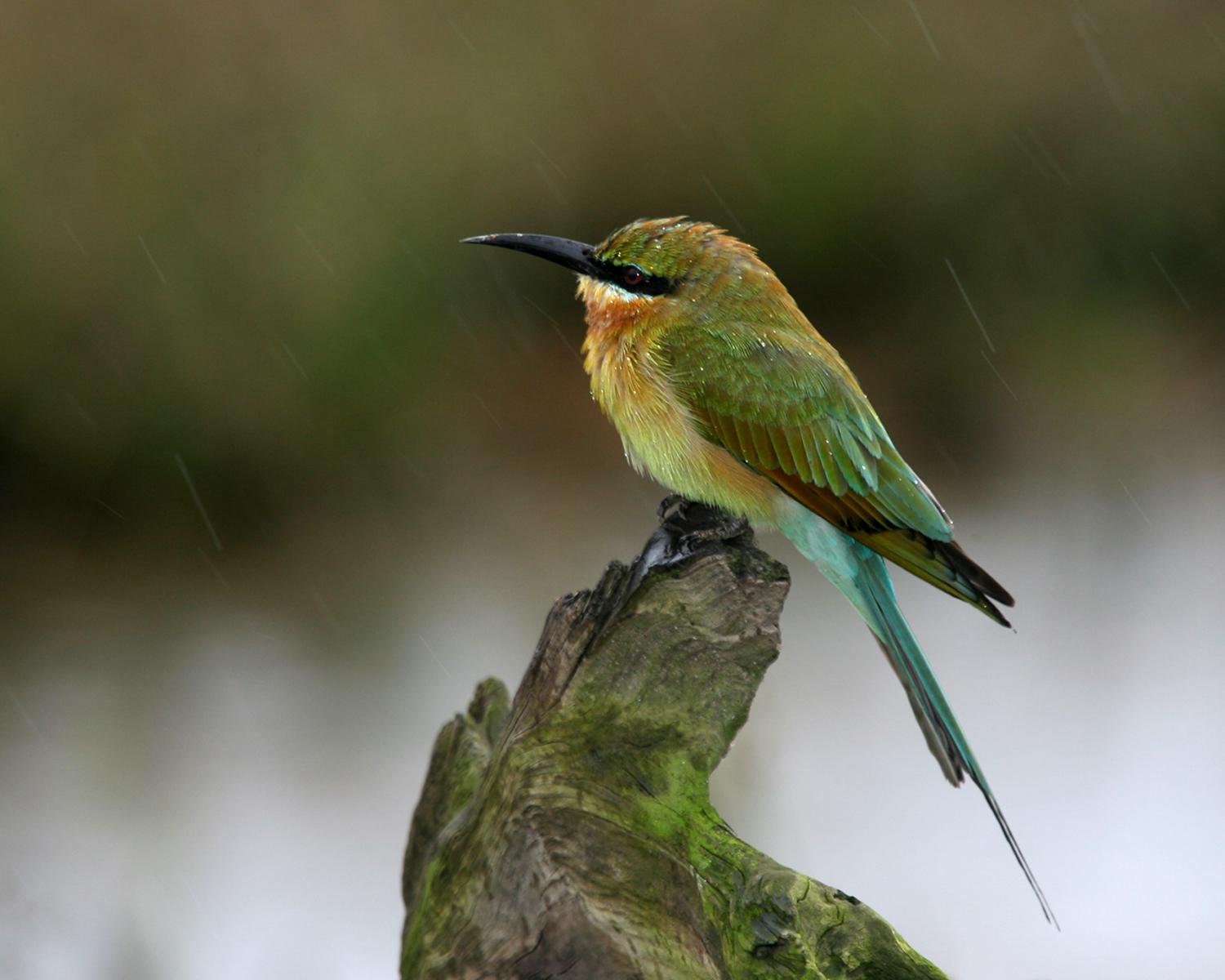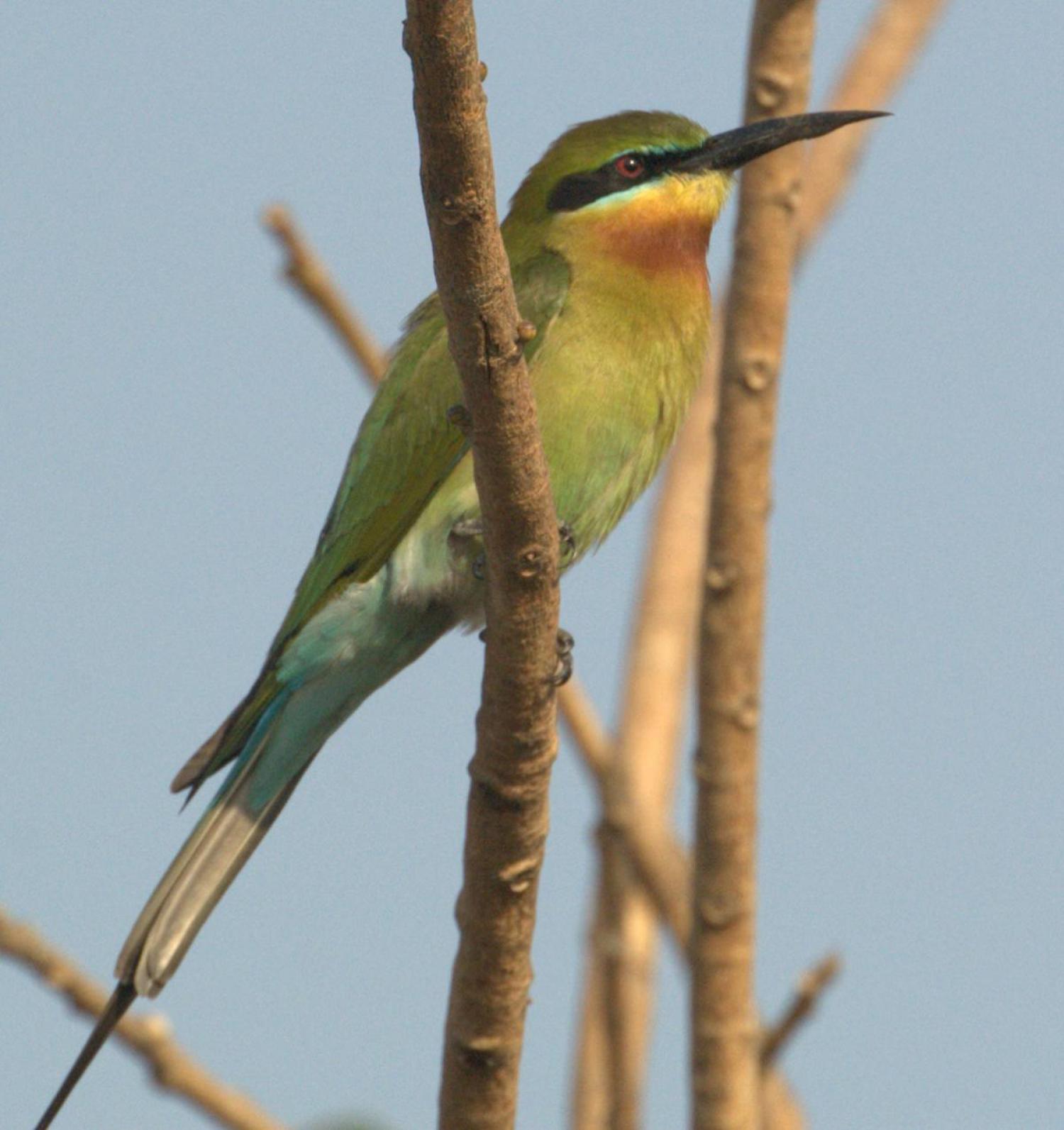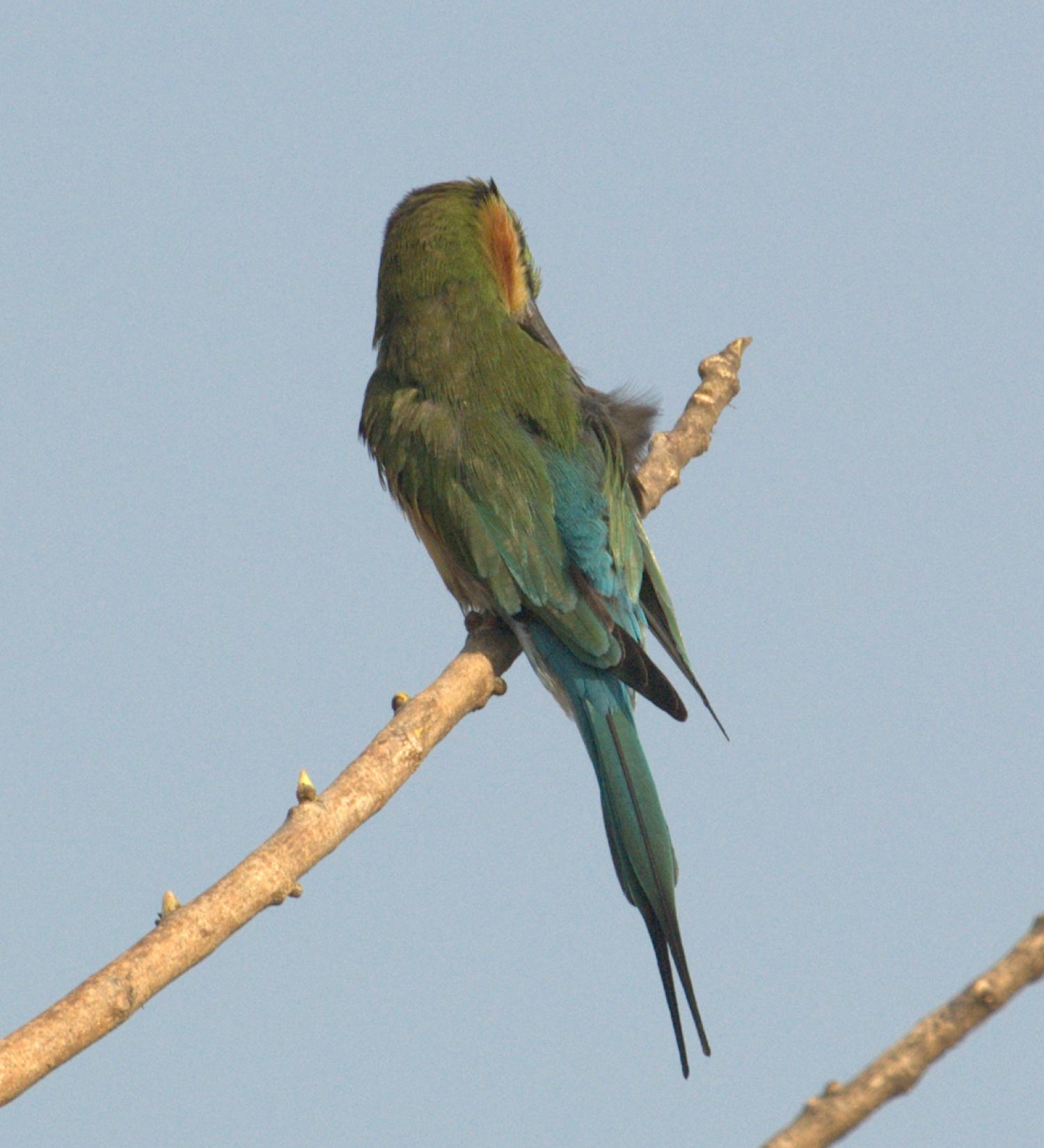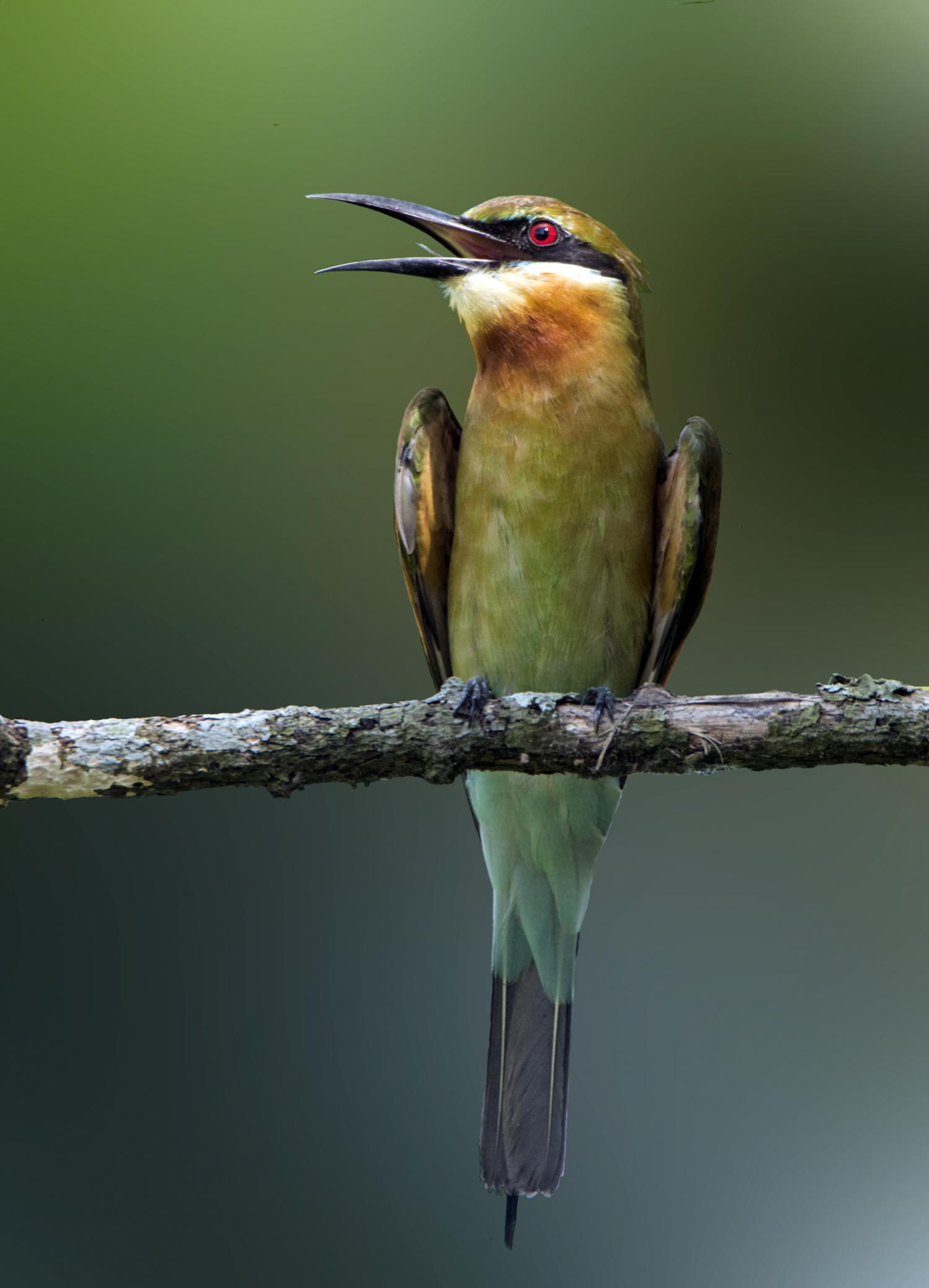Species of Thailand
Blue-tailed bee-eater
Merops philippinus
Carolus Linnaeus, 1766
In Thai: นกจาบคาหัวเขียว
The blue-tailed bee-eater (Merops philippinus) is a near passerine bird in the bee-eater family Meropidae. It is widely distributed across South and Southeast Asia where many populations are strongly migratory, and seen seasonally in many parts but breeding colonially in small areas across their range, mostly in river valleys, where the nest by tunneling into loamy sand banks. They are seen mostly in open habitats close to water.
Description
This species, like other bee-eaters, is a richly coloured, slender bird. It is predominantly green; its face has a narrow blue patch with a black eye stripe, and a yellow and brown throat; the tail is blue and the beak is black. The three outer toes are united around their bases. It can reach a length of 23–26 cm, including the two elongated central tail feathers which can jut two inches more than the remaining ten feathers. Sexes are alike. This species is usually found near water and like other bee-eaters it predominantly eats flying insects, especially bees (as large as the Xylocopa sp.), wasps and hornets, which are caught in the air by sorties from an open perch. They may also forage in flight over estuaries, backwaters and even over the sea but not far from the coast. This species probably takes bees and dragonflies in roughly equal numbers. The insects that are caught are beaten on the perch to kill and break the exoskeleton. This habit is seen in many other members of the order Coraciiformes. They call mainly in flight with a rolling chirping whistling .
The only confusable species within its range is the blue-cheeked bee-eater which however tends to be found in drier areas. The blue-tailed differs in having the rump and tail blue rather than green and black. The undertail feathers are bluish rather than green in the blue-cheeked. The blue cheek patch is much smaller while the chestnut on the throat and breast darker and covering a larger area.
They breed in April to May in India nesting colonially with closely placed nest holes in a vertical vertical mudbank or even burrowing into gently sloping land. They tend to choose sandy and sandy clay loams but avoid heavier clay loams. They also prefer clear mud banks without any vegetation cover. In Sri Lanka, they have been noted to breed in artificial sand dunes created by dredging of sea sand. The nest tunnel can run nearly 2 metres deep. About 5 to 7 near spherical eggs are laid. Both the male and the female take care of the eggs. The parents guard the nest to prevent intraspecific brood parasitism and extra pair copulation. These birds also feed and roost communally. One or two helpers may join the breeding pair after incubation begins. Although males and females appear similar to the human eye, males tend to have longer central tail feather extensions and UV reflectance studies demonstrate that healthy males had darker chestnut throats and brighter green body plumage while females showed brighter blue rumps and yellow chins.
Taxonomy and systematics
This species has sometimes been considered to be conspecific with the blue-cheeked bee-eater which is a close sister taxon, the two forming a clade with the Madagascan olive bee-eater. In the past the species has been treated variously as M. persicus javanicus, M. superciliosus javanicus, and M. superciliosus philippinus.
Ecological interactions
Based on the presence of spores of Nosema ceranae in the droppings of blue-tailed bee-eaters, it has been suggested that they may be capable of distributing the parasite to bees across a wide geographic range. A species of feather louse, Brueelia superciliosa has been described from hosts of this species in Thailand.
Distribution and movements
The species has a patchy breeding distribution across India, Myanmar, and parts of Southeast Asia. In India they are known to breed in several of the river valleys including those of the Godavari, Kaveri, and Krishna rivers. They also nest in the eastern parts of Sri Lanka.
Blue-tailed bee-eaters are seasonal in many parts of their range and are known to migrate diurnally en masse at some places like Tanjung Tuan (W. Malaysia) and Promsri Hill (southern Thailand). They are winter visitors in parts of Malaysia and peninsular India. The non-breeding ranges of the blue-cheeked bee-eater and blue-tailed overlap in some parts of Gujarat and western peninsular India.
Status
The Blue-tailed bee-eater is listed as a species of least concern by the International Union for the Conservation of Nature.
This article uses material from Wikipedia released under the Creative Commons Attribution-Share-Alike Licence 3.0. Eventual photos shown in this page may or may not be from Wikipedia, please see the license details for photos in photo by-lines.
Category / Seasonal Status
Wiki listed status (concerning Thai population): Resident, winter visitor and passage migrant
BCST Category: Recorded in an apparently wild state within the last 50 years
BCST Seasonal statuses:
- Resident or presumed resident
- Non-breeding visitor
Scientific classification
- Kingdom
- Animalia
- Phylum
- Chordata
- Class
- Aves
- Order
- Coraciiformes
- Family
- Meropidae
- Genus
- Merops
- Species
- Merops philippinus
Common names
- Thai: นกจาบคาหัวเขียว
Conservation status

Least Concern (IUCN3.1)
Photos
Please help us review the bird photos if wrong ones are used. We can be reached via our contact us page.
Range Map
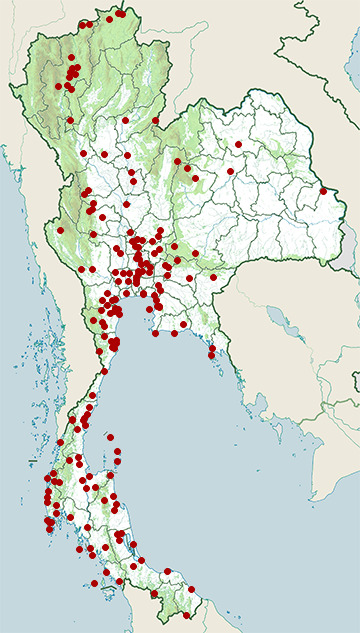
- Amphawa District, Samut Songkhram
- Ao Manao-Khao Tanyong National Park
- Ao Phang-Nga National Park
- Ban Laem District, Phetchaburi
- Ban Lat District, Phetchaburi
- Ban Pho District, Chachoengsao
- Ban Phraek District, Phra Nakhon Si Ayutthaya
- Ban Sang District, Prachinburi
- Bang Ban District, Phra Nakhon Si Ayutthaya
- Bang Len District, Nakhon Pathom
- Bang Pa In District, Phra Nakhon Si Ayutthaya
- Bang Pahan District, Phra Nakhon Si Ayutthaya
- Bang Pakong District, Chachoengsao
- Bang Phra Non-Hunting Area
- Bang Pu Recreation Centre
- Bang Saphan Noi District, Prachuap Khiri Khan
- Bangkok Province
- Bueng Boraped Non-Hunting Area
- Chaiya District, Surat Thani
- Chaiyo District, Ang Thong
- Chiang Saen District, Chiang Rai
- Doi Inthanon National Park
- Doi Lo District, Chiang Mai
- Doi Pha Hom Pok National Park
- Doi Suthep - Pui National Park
- Don Chedi District, Suphan Buri
- Hala-Bala Wildlife Sanctuary
- Hat Chao Mai National Park
- Hat Wanakon National Park
- Hat Yai District, Songkhla
- Hua Hin District, Prachuap Khiri Khan
- Huai Kha Khaeng Wildlife Sanctuary
- In Buri District, Sing Buri
- Kabin Buri District, Prachinburi
- Kaeng Khoi District, Saraburi
- Kaeng Krachan District, Phetchaburi
- Kaeng Krachan National Park
- Kaeng Krung National Park
- Kamphaeng Saen District, Nakhon Pathom
- Kaset Sombun District, Chaiyaphum
- Khanom District, Nakhon Si Thammarat
- Khao Dinsor (Chumphon Raptor Center)
- Khao Khiao - Khao Chomphu Wildlife Sanctuary
- Khao Laem National Park
- Khao Laem Ya - Mu Ko Samet National Park
- Khao Lak - Lam Ru National Park
- Khao Luang National Park
- Khao Phra - Bang Khram Wildlife Sanctuary
- Khao Phra Thaeo Wildlife Sanctuary
- Khao Sam Roi Yot National Park
- Khao Sok National Park
- Khao Yai National Park
- Khao Yoi District, Phetchaburi
- Khemarat District, Ubon Ratchathani
- Khlong Luang District, Pathum Thani
- Khon San District, Chaiyaphum
- Khuan Khanun District, Phatthalung
- Khura Buri District, Phang Nga
- Klaeng District, Rayong
- Ko Chang National Park
- Ko Lanta National Park
- Ko Libong
- Ko Phra Thong
- Ko Samui District, Surat Thani
- Ko Sichang District, Chonburi
- Ko Tao
- Kromluang Chumphon Wildlife Sanctuary
- Kui Buri National Park
- Kumphawapi District, Udon Thani
- Laem Ngop District, Trat
- Laem Pak Bia
- Lan Sak District, Uthai Thani
- Mae Ai District, Chiang Mai
- Mae Chan District, Chiang Rai
- Mae Ping National Park
- Mae Poen District, Nakhon Sawan
- Mae Rim District, Chiang Mai
- Mae Taeng District, Chiang Mai
- Mae Wong National Park
- Mu Ko Chumphon National Park
- Mu Ko Phetra National Park
- Mueang Chachoengsao District, Chachoengsao
- Mueang Chiang Mai District, Chiang Mai
- Mueang Chonburi District, Chonburi
- Mueang Chumphon District, Chumphon
- Mueang Kanchanaburi District, Kanchanaburi
- Mueang Khon Kaen District, Khon Kaen
- Mueang Krabi District, Krabi
- Mueang Lopburi District, Lopburi
- Mueang Nakhon Nayok District, Nakhon Nayok
- Mueang Nakhon Pathom District, Nakhon Pathom
- Mueang Nakhon Si Thammarat District, Nakhon Si Thammarat
- Mueang Nonthaburi District, Nonthaburi
- Mueang Pathum Thani District, Pathum Thani
- Mueang Pattani District, Pattani
- Mueang Phang Nga District, Phang Nga
- Mueang Phatthalung District, Phatthalung
- Mueang Phetchaburi District, Phetchaburi
- Mueang Phichit District, Phichit
- Mueang Phitsanulok District, Phitsanulok
- Mueang Phuket District, Phuket
- Mueang Ranong District, Ranong
- Mueang Ratchaburi District, Ratchaburi
- Mueang Samut Sakhon District, Samut Sakhon
- Mueang Samut Songkhram District, Samut Songkhram
- Mueang Saraburi District, Saraburi
- Mueang Satun District, Satun
- Mueang Songkhla District, Songkhla
- Mueang Suphanburi District, Suphan Buri
- Mueang Surat Thani District, Surat Thani
- Mueang Tak District, Tak
- Mueang Uttaradit District, Uttaradit
- Nam Nao National Park
- Nong Bong Khai Non-Hunting Area
- Nong Suea District, Pathum Thani
- Nong Thung Thong Non-Hunting Area
- Nong Ya Plong District, Phetchaburi
- Nong Yai Area Development Project Under Royal Init
- Op Khan National Park
- Pa Sak Chonlasit Dam Non-Hunting Area
- Pa Sang District, Lamphun
- Pak Chong District, Nakhon Ratchasima
- Pak Kret District, Nonthaburi
- Pak Phli District, Nakhon Nayok
- Pak Thale
- Pak Tho District, Ratchaburi
- Pang Sila Thong District, Kamphaeng Phet
- Pathio District, Chumphon
- Phatthana Nikhom District, Lopburi
- Phra Nakhon Si Ayutthaya District, Phra Nakhon Si Ayutthaya
- Phra Phrom District, Nakhon Si Thammarat
- Phu Soi Dao National Park
- Phu Toei National Park
- Phunphin District, Surat Thani
- Phutthamonthon District, Nakhon Pathom
- Pran Buri District, Prachuap Khiri Khan
- Pran Buri Forest Park
- Ramkhamhaeng National Park
- Sai Noi District, Nonthaburi
- Sai Yok District, Kanchanaburi
- Sakaerat Environmental Research Station
- Sam Roi Yot District, Prachuap Khiri Khan
- Samae San Island
- Samut Prakan Province
- San Kala Khiri National Park
- San Sai District, Chiang Mai
- Sathing Phra District, Songkhla
- Sawi District, Chumphon
- Si Racha District, Chonburi
- Sirinat National Park
- Sri Phang Nga National Park
- Tai Rom Yen National Park
- Takua Pa District, Phang Nga
- Taphan Hin District, Phichit
- Tarutao National Marine Park
- Tha Chana District, Surat Thani
- Tha Chang District, Sing Buri
- Tha Sala District, Nakhon Si Thammarat
- Tha Wung District, Lopburi
- Tha Yang District, Phetchaburi
- Thai Mueang District, Phang Nga
- Thalang District, Phuket
- Thale Noi Non-Hunting Area
- Tham Pratun Non-Hunting Area
- Than Sadet - Koh Pha-Ngan National Park
- Thanyaburi District, Pathum Thani
- Thao Kosa Forest Park
- Wang Mai Forest Restoration Project
- Wang Noi District, Phra Nakhon Si Ayutthaya
- Wat Phai Lom & Wat Ampu Wararam Non-Hunting Area
- Wat Tham Erawan Non-Hunting Area
- Watthana Nakhon District, Sa Kaeo
- Yan Ta Khao District, Trang
